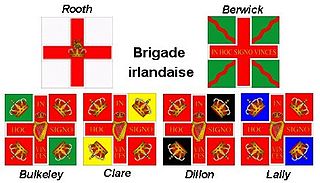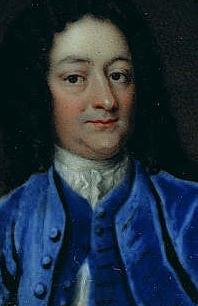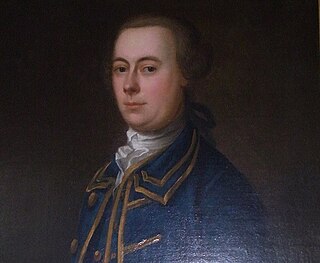
The Battle of Dettingen took place on 27 June 1743 during the War of the Austrian Succession at Dettingen in the Electorate of Mainz, Holy Roman Empire. It was fought between a Pragmatic Army, composed of the British, Hanoverian and Austrian troops, and a French army commanded by the duc de Noailles.

Prince William Augustus, Duke of Cumberland was the third and youngest son of King George II of Great Britain and Ireland and his wife, Caroline of Ansbach. He was Duke of Cumberland from 1726. He is best remembered for his role in putting down the Jacobite Rising at the Battle of Culloden in 1746, which made him popular in certain parts of Britain. He is often referred to by the nickname given to him by his Tory opponents: 'Butcher' Cumberland.

The Battle of Fontenoy took place on 11 May 1745 during the War of the Austrian Succession, near Tournai, then part of the Austrian Netherlands, now in Belgium. A French army of 50,000 under Marshal Saxe defeated a Pragmatic Army of roughly the same size, led by the Duke of Cumberland.

Field Marshal Sir George Howard KB, PC was a British military officer and politician. After commanding the 3rd Regiment of Foot at the Battle of Fontenoy in May 1745 during the War of the Austrian Succession and after commanding that regiment again at the Battle of Falkirk Muir and the Battle of Culloden during the Jacobite Rebellion, he returned to the continent and fought at the Battle of Lauffeld. He went on to command a brigade at the Battle of Warburg during the Seven Years' War. He subsequently became the Governor of Minorca.

The Irish Brigade was a brigade in the French Royal Army composed of Irish exiles, led by Lord Mountcashel. It was formed in May 1690 when five Jacobite regiments were sent from Ireland to France in exchange for a larger force of French infantry who were sent to fight in the Williamite War in Ireland. The regiments comprising the Irish Brigade retained their special status as foreign units in the French Army until nationalised in 1791.

The Somerset Light Infantry (Prince Albert's) was a light infantry regiment of the British Army, which served under various titles from 1685 to 1959. In 1959, the regiment was amalgamated with the Duke of Cornwall's Light Infantry to form the Somerset and Cornwall Light Infantry which was again amalgamated, in 1968, with the King's Own Yorkshire Light Infantry, the King's Shropshire Light Infantry and the Durham Light Infantry to form The Light Infantry. In 2007, however, The Light Infantry was amalgamated further with the Devonshire and Dorset Regiment, the Royal Gloucestershire, Berkshire and Wiltshire Regiment and the Royal Green Jackets to form The Rifles.

The Buffs (Royal East Kent Regiment), formerly the 3rd Regiment of Foot, was a line infantry regiment of the British Army traditionally raised in the English county of Kent and garrisoned at Canterbury. It had a history dating back to 1572 and was one of the oldest regiments in the British Army, being third in order of precedence (ranked as the 3rd Regiment of the line). The regiment provided distinguished service over a period of almost four hundred years accumulating one hundred and sixteen battle honours. In 1881, under the Childers Reforms, it was known as the Buffs (East Kent Regiment) and later, on 3 June 1935, was renamed the Buffs (Royal East Kent Regiment).

The 32nd Regiment of Foot was an infantry regiment of the British Army, raised in 1702. Under the Childers Reforms it amalgamated with the 46th Regiment of Foot to form the Duke of Cornwall's Light Infantry in 1881.

The Royal Scots Fusiliers was a line infantry regiment of the British Army that existed from 1678 until 1959 when it was amalgamated with the Highland Light Infantry to form the Royal Highland Fusiliers which was later itself merged with the Royal Scots, King's Own Scottish Borderers, the Black Watch, the Argyll and Sutherland Highlanders and the Highlanders to form a new large regiment, the Royal Regiment of Scotland.

Henry Hawley was a British army officer who served in the wars of the first half of the 18th century. He fought in a number of significant battles, including the Capture of Vigo in 1719, Dettingen, Fontenoy and Culloden.

The Battle of Falkirk Muir, or Battle of Falkirk, took place near Falkirk, Scotland, on 17 January 1746 during the Jacobite rising of 1745. A narrow Jacobite victory, it had little impact on the campaign.

Sir Harry Munro, 7th Baronet was 25th Baron and the 28th chief of the Clan Munro. He was a Scottish soldier and politician. He was loyal to the Hanoverian dynasty and served as a captain in Loudon's Highlanders Regiment 1745–48.
The 37th Regiment of Foot was a line infantry regiment of the British Army, raised in Ireland in February 1702. Under the Childers Reforms it amalgamated with the 67th Regiment of Foot to become the Hampshire Regiment in 1881.
The 48th (Northamptonshire) Regiment of Foot was a regiment of the British Army, raised in 1741. Under the Childers Reforms it amalgamated with the 58th (Rutlandshire) Regiment of Foot to form the Northamptonshire Regiment in 1881.
Loudon's Highlanders, or the 64th Highlanders, or Earl of Loudon's Regiment of Foot, was an infantry regiment of the British Army.

Lieutenant General John Huske was a British military officer whose active service began in 1707 during the War of the Spanish Succession and ended in 1748.

General William Belford was a British artillery officer who began his career in 1726. He was part of the first generation of artillery officers selected and promoted on merit, rather than connections.

James Cholmondeley was a British Army officer and Member of Parliament between 1731 and 1747.

The Jacobite Royal Scots, sometimes called the Royal-Ecossais, Lord John Drummond's Regiment or French Royal Scots, was a French military regiment made up mostly of Scottish Jacobite exiles. Formed in 1744 under a 1743 order, they are perhaps best known for serving in Scotland during the Jacobite rising of 1745.
The Battle of Culloden took place on 16 April 1746 at Culloden, Highland, near Inverness in the Scottish Highlands. A Jacobite army under Charles Edward Stuart was decisively defeated by a British government force under Duke of Cumberland, ending the Jacobite rising of 1745.















